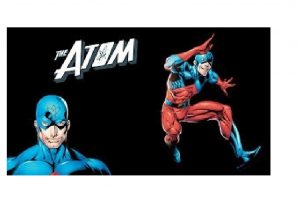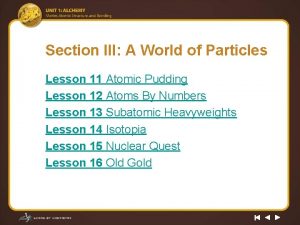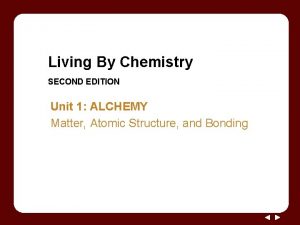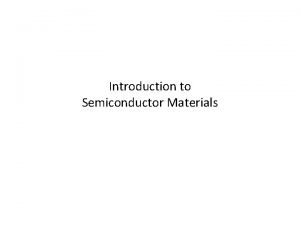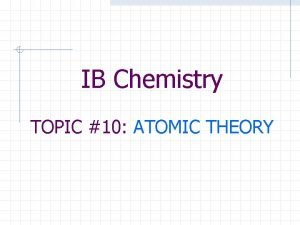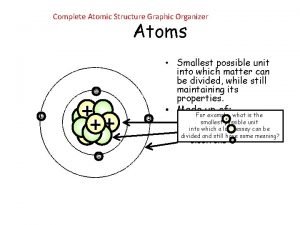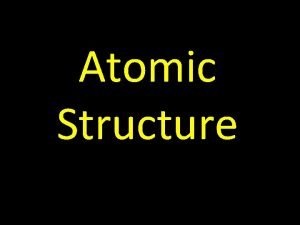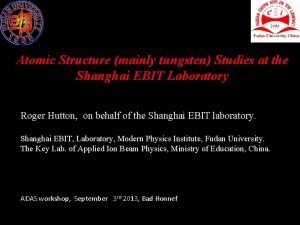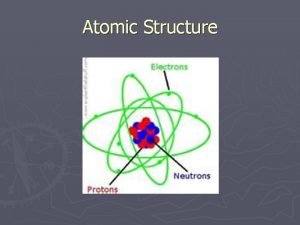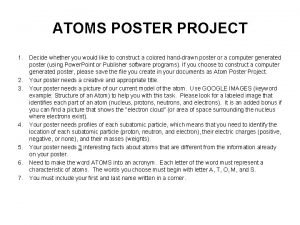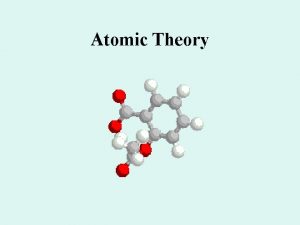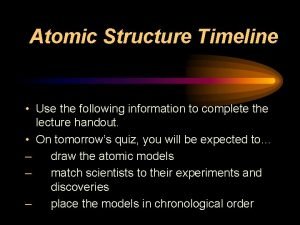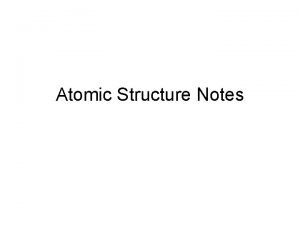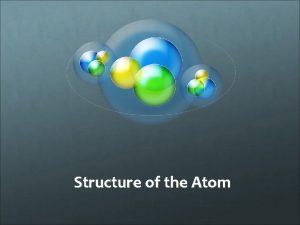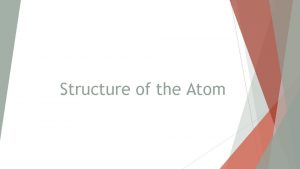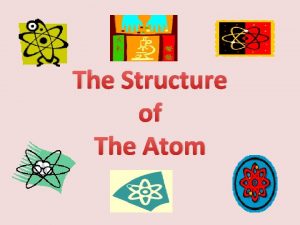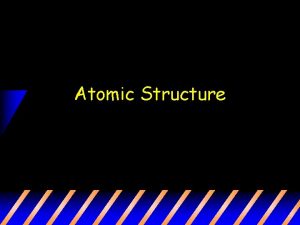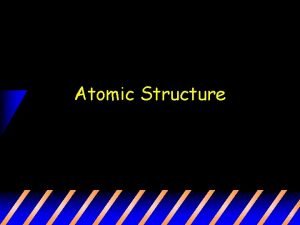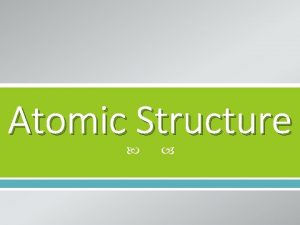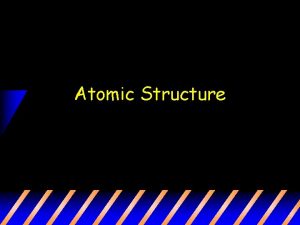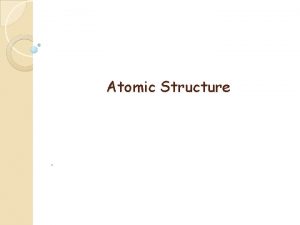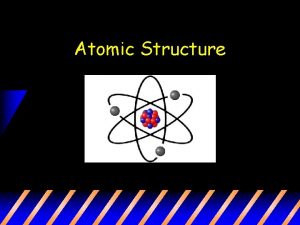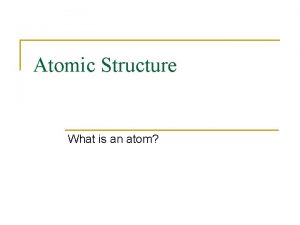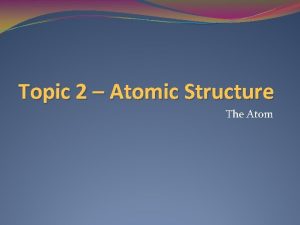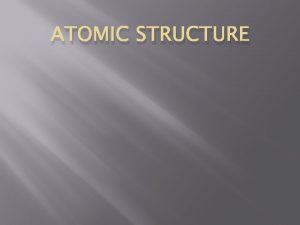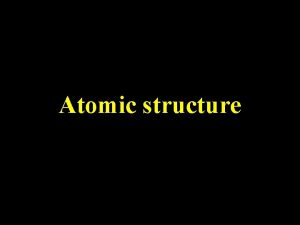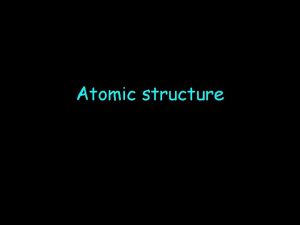ATOMIC STRUCTURE What is an atom What is
























- Slides: 24

ATOMIC STRUCTURE What is an atom? What is the structure of an atom? How is an atom different from an element? How is it different from compound?

Definition: • An atom is the smallest particle of matter that still retains the property of that substance. • It is the basic unit of matter, much the cell is the basic unit of all living things.

Structure: a small, dense nucleus surrounded by orbiting electrons.

Subatomic Particles: (particles that make up atoms) Three types of particles: PROTONS NEUTRONS ELECTRONS

PROTONS • Positively charged particles • Located in the nucleus of the atom • Contribute to the mass of the atom

Neutrons • Have no charge. • Located in the nucleus of the atom. • Contribute to the mass of the atom.

Electrons • Have a negative charge • Located outside of the nucleus • Do NOT contribute to the mass of the atom

Wait…. so let me get this straight…. . Particle Location Charge Mass Proton Nucleus Positive 1 amu Neutron Nucleus Neutral 1 amu Electron Outside Nucleus Negative None

The whole picture…

What is an element? ? ? • An element is a substance made up of one type of atom. • Example: gold, tin, oxygen (anything on the periodic table)

So…. • Atoms make up elements. • All atoms of the same element are alike, and different from atoms of other elements. – For example, all gold atoms are the same, but different from oxygen atoms.

Atomic Number… • The atomic number is the number of protons in an atom. • Each type of atom has a different number of protons.

Atomic Number All atoms of lead (Pb) have 82 protons.

Atomic Mass • Atomic Mass or Mass Number—number of protons plus neutrons. Ø atomic mass = # protons + # neutrons Ø # neutrons = atomic mass - # protons Ø # protons = atomic mass - # neutrons

Let’s Try this… • How many protons are in an atom of Carbon? 6 protons • How many protons in an atom of Hydrogen? 1 proton

Now let’s try mass…. • What is the mass of an atom containing 14 protons and 12 neutrons? – 14 + 12 = 26 amu • What is the mass of an atom containing 10 protons and 10 neutrons? – 10 + 10 = 20 amu • What is the mass of a sulfur atom containing 15 neutrons? - 15 + 16 (protons) = 31 amu

Another Example… • What is the mass of an atom with 6 protons and 6 neutrons? – What is the identity of this atom? What is the mass of an atom with 6 protons and 7 neutrons? What is the identity of this atom?

Isotopes Two atoms of the same element with different masses. Example: Carbon-12 Carbon-13

What is a compound? ? • A compound is a substance composed of two or more elements chemically bonded. – Examples: water, carbon dioxide, baking soda H 2 O

The Bottom Line… • All atoms are made up of protons, neutrons and electrons. • All matter is made up of atoms. • All elements are made up of atoms. • All compounds are made up of elements.

What about electrons? • Electrons are located outside the nucleus. • They orbit the nucleus in a complex pattern at different levels. • The outermost electrons – those farthest from the nucleus are called VALENCE ELECTRONS

Here is the basic structure: Valence electrons What is the identity of this atom? What is the mass of this atom?

The formation of ions… Neutral atom Ion Two valence electrons are lost 30 protons (zinc) 30 electrons 0 = neutral atom 30 protons (still zinc) 28 electrons + 2 charge

Try this…. • What is the charge of an ion with 24 protons and 26 electrons? • -2 • What is the charge of an ion with 12 protons and 11 electrons? +1
 The structure of the atom section 2 defining the atom
The structure of the atom section 2 defining the atom Is atomic mass and relative atomic mass the same
Is atomic mass and relative atomic mass the same Periodic trends
Periodic trends Periodic trends
Periodic trends Difference between atomic mass and mass number
Difference between atomic mass and mass number Atomic mass and atomic number difference
Atomic mass and atomic number difference Atomic number vs atomic radius
Atomic number vs atomic radius The atoms family atomic math challenge
The atoms family atomic math challenge Lesson 11 atomic pudding models of the atom
Lesson 11 atomic pudding models of the atom Atomic alchemy
Atomic alchemy Gambar teori atom democritus
Gambar teori atom democritus Atomic structure and properties ap chemistry
Atomic structure and properties ap chemistry Atom subatomic particles
Atom subatomic particles 460 democritus atom model
460 democritus atom model Rectification formula
Rectification formula What is z in atomic structure
What is z in atomic structure Ib chemistry atomic structure
Ib chemistry atomic structure Atomic theory graphic organizer
Atomic theory graphic organizer Models of the atom timeline
Models of the atom timeline Z atomic symbol
Z atomic symbol Tungsten atomic structure
Tungsten atomic structure 460 bc atomic structure
460 bc atomic structure Atoms poster
Atoms poster Atomic structure graphic organizer
Atomic structure graphic organizer James chadwick atomic model
James chadwick atomic model







